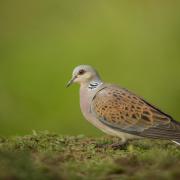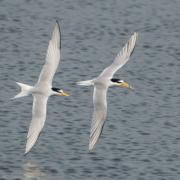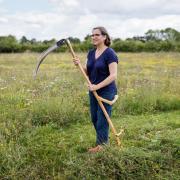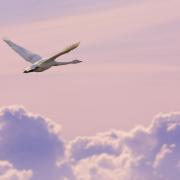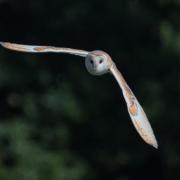Moving in, moving out or simply settling down, Suffolk's wildlife is now preparing for the challenge of winter, as John Grant explains
Moving in, moving out or simply settling down, Suffolk’s wildlife is now preparing for the challenge of winter, as John Grant explains
November is nature’s nearly month. The autumn is nearly over, and, although some of us may say ‘perish the thought,’ the long, dark days of winter are nearly upon us.The miracles of migration we have witnessed over the past few weeks have nearly ceased, the year is nearly at an end and much in the Suffolk countryside has nearly gone to sleep.In all those cases the key word is nearly – nearly, but not quite.Take migration. For the naturalist, the very word conjures up visions that are so awe-inspiring there is barely a word in the English language that does it justice. We saw this spectacle reach its peak in September and October as myriad migrating birds arrived in Suffolk from far-flung shores, either to spend the entire winter with us or use our county’s bounties as fuel for another mind-boggling leg of a mind-boggling journey to who knows where.Weather-induced movements from the Continent into Britain, or from Britain to some point south, may well take place during the winter but the more widely recognised phenomenon of migration – the regular, seasonal movement of organisms from summer quarters to winter quarters all across our planet – is now easing down, at least for many bird species.However, especially in the first half of November, there is often an autumnal ‘sting in the tail’ – a late surge of the more hardy species from the far north. If we have an ‘Indian summer’ it is even quite probable that some summer visitors may linger with us – species as quintessentially part of the British summer as swallow and house martin are increasingly being recorded during the month. But it is the more northerly species that really spice up a November’s day along the Suffolk coast. A brisk northerly breeze will bring in a host of seabirds to our inshore waters – sea duck such as eider, common and velvet scoters and long-tailed duck can well be watched headed south past our resorts that are themselves preparing for the winter months ahead.Also at sea in a November northerly will be the one species that ornithologists associate more than any other with the month – the endearing, diminutive little auk. This tiny waif from the high Arctic has a massive population – some 12.75 million pairs are thought to breed between Baffin Island in the west and the evocatively named Severnaya Zemlya in the east – and most winter around the edge of the pack ice. But some disperse further south and, with a northerly blow pushing them into the North Sea, they can sometimes be seen whirring along on stubby little wings off our shores in what is known as a ‘wreck’ of displaced birds seeking their required zooplankton and small fish far from their ice-gripped summer homes.Inland, however, the spectacle of November is not what it once was. In the not-too-distant past, great feeding flocks of sparrows, finches and buntings would congregate on Suffolk’s stubble fields, ekeing out a winter subsistence of various seeds and grains. Not so now. The onslaught of winter-sown cereal crops has seen to that. Stubble is now a rare habitat in winter, more’s the pity, and our farmland breeding birds – yellowhammers, corn buntings and the like, together with their visiting cousins from the Continent, suffer catastrophic losses as a result.Some creatures, however, have a rather canny way of avoiding the need to exploit dwindling winter food supplies. These, of course, are our hibernators. Just imagine, missing out on winter altogether and indulging in the laziest of all activities – months of sleep!Well, it may sound an attractive proposition but there is a catch. Before the humble hedgehog and his fellow hibernators can settle down to pass away the winter months in suspended animation, they have to prepare for it by storing up the fat reserves throughout November to see them through until the warmth of next spring causes them to stir once more.So all the British bats, our dormice, frogs toads, newts, slow worms, snakes and many insects – the hibernators and those species that enter a winter torpor – still face the challenge of survival. And they have to choose the right place for their winter slumber too. Hibernation really isn’t as simple as it sounds.Many’s the time a sleeping hedgehog, for example, has had a rude awakening as the bonfire under which it has snuggled suddenly starts going up in smoke and flames…the perils faced by our wildlife are many and varied indeed.For some humans, November might well mark a time for a good brisk walk in the Suffolk countryside followed by feet-up at home and some “hibernation” of their own, albeit for just a few hours! Peter Lawson, our old botanist friend has, as ever, some advice for us. He writes: “Now we have reached November there are few wild flowers to be found, with just the occasional bloom produced on re-growth from earlier verge cutting. Until the first frosts come, though, do look out for unfamiliar flowers and grasses under your bird feeders, as in mild autumns many of these seeds will germinate and grow quickly to maturity, and may even flower.“This is a time for finding out more about those unfamiliar wildflowers you have seen during the past year, some of which I have highlighted in these articles. This year saw the publication of A Flora of Suffolk by Martin Sanford and Richard Fisk. This attractive and beautifully illustrated book of 550 pages gives information on every plant ever recorded in the wild in this county, covering locations, habitats, history and lots more. All except the commonest have a dot map showing their distribution, and many are illustrated. Chapters on habitats, geology and agricultural crops over the past 150 years all help to explain how and why our flora is what it is.“This beautifully presented book, containing as it does colour photographs of habitats and individual plants, would make, at �40, a wonderful Christmas present for anyone interested in our Suffolk flora.”And with thoughts turning to Christmas, the year seems to have flashed by. It’s nearly over but, like the many natural “nearlies” of November, not quite. December may have some surprises in store for us – and not just those we find in our Christmas stockings!
NOW'S THE TIME TO SEE
BRENT GEESE: Streaming past our coastline in great lines that sometimes stretch for many hundreds of birds, the dark-bellied brent geese are heading for our shores. Their welcome arrival with us is a stirring November sight as they head into our estuaries from their far-off breeding grounds along the Arctic coasts of northern Siberia, particularly the Taimyr Peninsula.With onshore winds, these small dark geese can be seen low over the sea close in along the entire Suffolk coast. Their cousins, the pale-bellied brent from Svalbard and the black brant from North America and far eastern Asia, are sometimes seen in Suffolk but the dark-bellied birds are now firmly established winter visitors in their thousands.If you have not witnessed a big coastal migration never fear, they can be seen in and around the south Suffolk estuaries, particularly those of the rivers Deben, Orwell and Stour, throughout the winter. Make a date with them, they are an enchanting species and their soft calls are a winter’s delight.

















